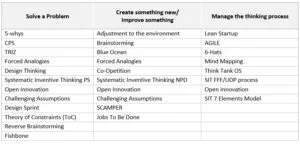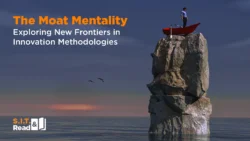Innovation Behavior
Innovation is a skill, not a gift. Top organizations drive growth by nurturing and investing in innovation as a competency. One way organizations make it real is by including innovation within formal competency models.
Professor Rodney Rogers of Portland State University defines a competency as a persistent pattern of behavior resulting from a cluster of knowledge, skills, abilities, and motivations. It is the persistence of those behaviors that matter most and help your organization succeed.
Competency models are a useful way to formalize that behavior and make it persistent. They help describe the ideal patterns needed for exceptional performance. They are a blueprint for the type of person needed for a specific job. And they help diagnose and evaluate employee performance. It takes a lot of work to develop one, but it’s worth it.
My approach is to see innovation competencies at two distinct levels: The Innovator, and The Innovation Leader. Here is how to think about it.
The Innovator Competencies:
- Generating Innovative Solutions – Systematically innovates using a model with proven efficacy; routinely innovates products, services, processes, and strategies; values and harnesses team diversity; reframes problems in a different light to find fresh approaches; entertains wide-ranging possibilities others may miss; takes advantage of difficult or unusual situations to develop unique approaches and useful solutions.
- Seeing the Big Picture – Has broad knowledge and perspective; pieces together seemingly unrelated data to identify patterns and trends and to see a bigger picture; understands the pieces of a system as a whole and appreciates the consequences of actions on other parts of the system; possesses a big-picture view of the situation.
The Innovation Leader competencies are different. It is not necessarily the innovation leader who must generate new ideas; rather, they must understand how to instill innovation according to Penn State researcher, Dr. David G. Gliddon. “Commitment to innovation as a culture is prevalent in organizations as it is commonly woven directly into mission statements. However, leaders still lack the ability to plan, measure and implement innovative programs, products and services. These challenges are enhanced by the pressure to juggle several different and often conflicting roles.” said Gliddon. In a three-year study, Gliddon identified the competencies that underpinned these roles and developed a competency model of innovation leaders. The competency model can be tailored to any organization as part of a competency-based human resource development initiative.
An innovation leader collaboratively interacts with their employees and supports high levels of teamwork, providing opportunities to share innovations. Once an innovation has been shared, employees should be empowered to then adopt the innovation if it is useful. Employees can then support the innovation leader by initially adopting the innovation, and encourage the diffusion of the innovation throughout organization’s social system, Gliddon says. Innovation leaders must also take personal responsibility for and be dedicated to projects that require innovations. Therefore, innovation leaders must establish a trust culture and maintain relationships based on trust. They must display initiative, set challenging project goals, and link those goals to the needs of the customer, department, and enterprise, according to his study. Persistent innovation behavior by the leader and innovator is a recipe for growth.











